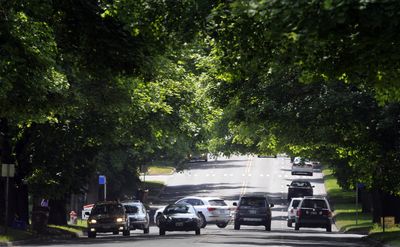Group lends support to urban forest
Spokane Preservation Advocates invites speaker to discuss trees’ role in public spaces

Spokane Preservation Advocates, an organization that has fought to save historic buildings over the years, is branching out this month to preserve mature street trees.
Members are concerned that Spokane city policies are encouraging small trees along city streets at the expense of big ones.
City officials said they are trying to solve problems created by large trees in small spaces, not forgoing large trees altogether. They want healthy trees that don’t damage pavement or send branches into utility lines.
The city requires permits for new trees or major pruning in city rights of way.
While small trees are useful, “They are not what a lot of people want in an urban forest,” said urban forestry expert Michael Kuhns, a professor at Utah State University.
Spokane Preservation Advocates has invited Kuhns to speak at 7 p.m. Thursday at Interplayers.
While people love arching canopies, Kuhns said, mature trees should not be planted in parking strips that are only three or four feet wide.
“It’s hard to have a viable safe tree in a space that small,” he said. A lawn strip along the street needs to be at least six to eight feet wide to accommodate a large tree, he said.
Neighborhood advocates have fought City Hall in recent years over tree removals during reconstruction of Bernard Avenue and other streets.
The advocacy group’s Suzanne Schreiner said her organization’s mission calls for preserving landscapes and neighborhood character, in addition to fighting for historic structures.
The group’s members are concerned about the long-term effect of the city encouraging smaller trees. “How would that change the landscape of Spokane?” she asked.
Kuhns said large trees can increase the value of a home; reduce air conditioning costs; slow heavy storm runoff; shade asphalt decay; ease wind speeds; cool the outdoor environment; and increase habitat for wildlife.